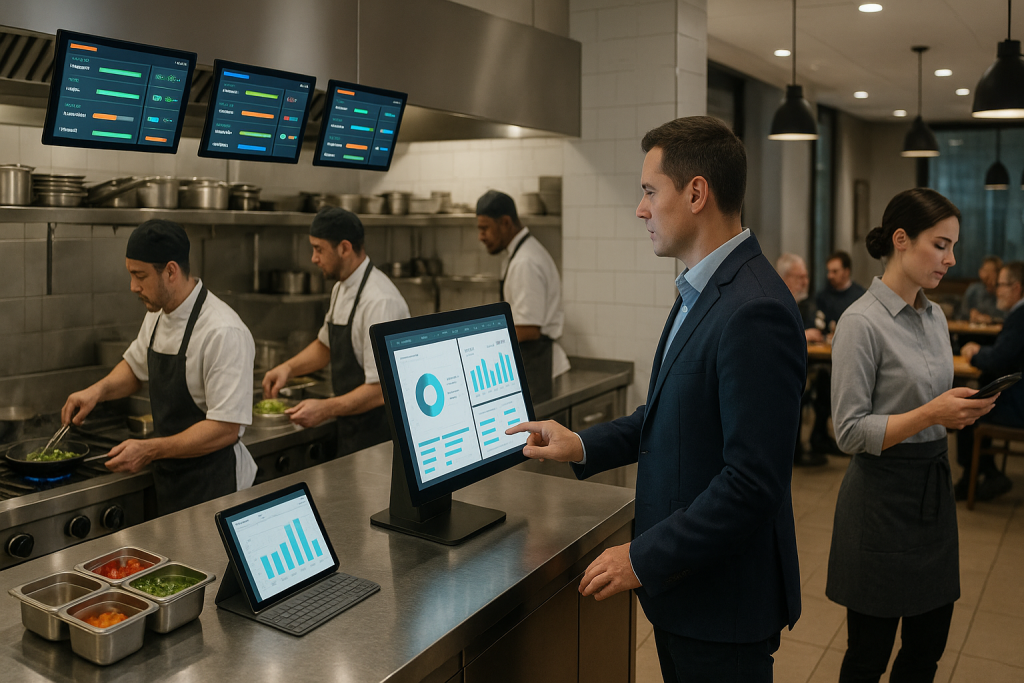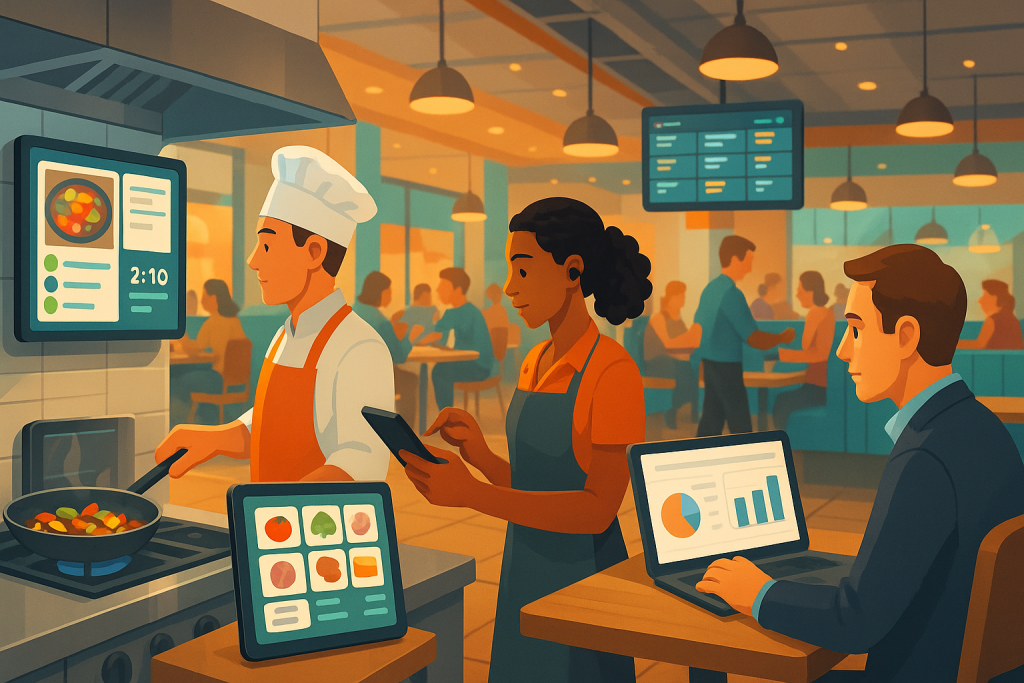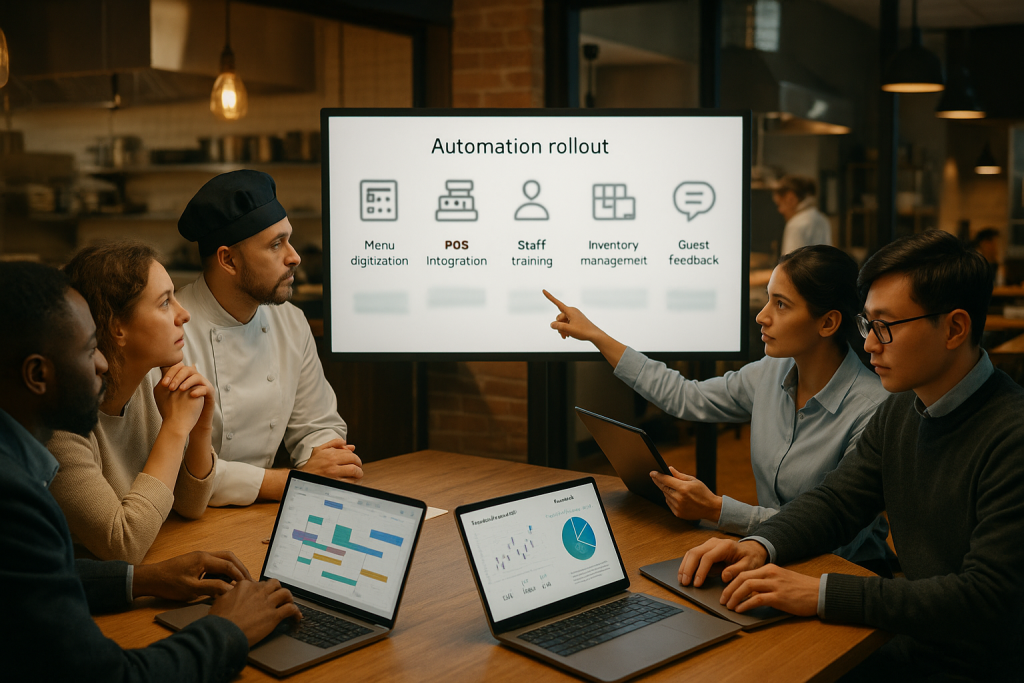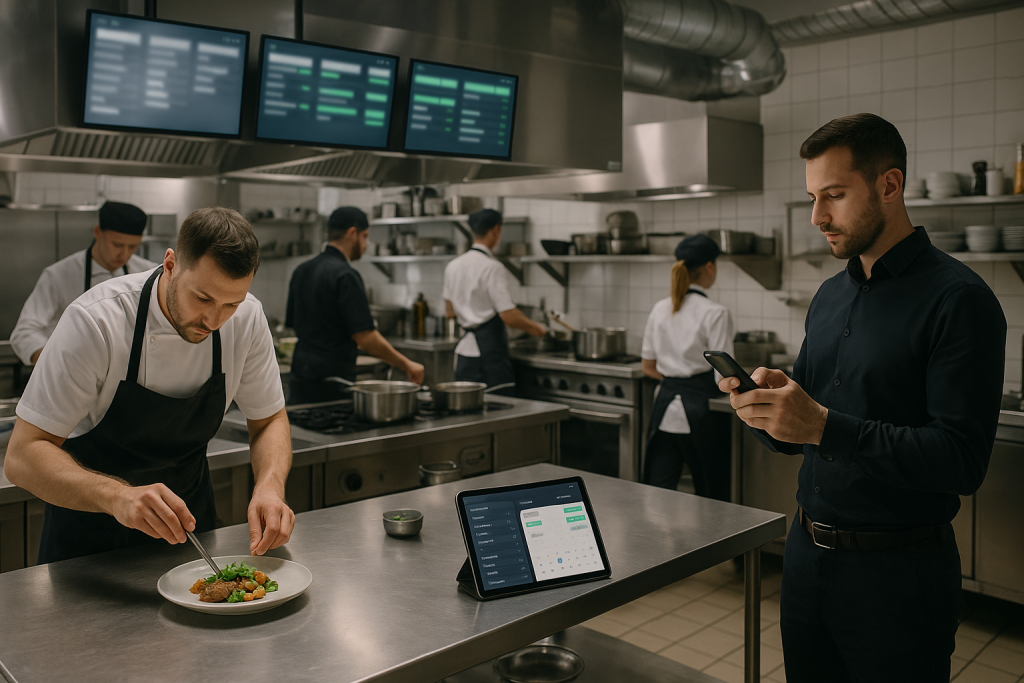By Bruce Gordon, CEO of Profit Solutions
In my 38 years of helping businesses optimize their operations, I’ve discovered that restaurants face some of the most complex operational challenges of any industry. You’re managing inventory with short shelf lives, coordinating kitchen timing for multiple orders, handling unpredictable customer demand, and maintaining quality standards—all while operating on notoriously thin profit margins where small inefficiencies can make the difference between success and failure.
The $340,000 Annual Efficiency Crisis in Restaurant Operations
Let me paint a picture that every restaurant owner will immediately recognize. Recently, I worked with a successful family restaurant doing $2.1 million in annual sales. The food was excellent, the location prime, but they were losing money due to operational inefficiencies that were slowly killing their profitability.
Here’s what their daily operations looked like:
- Food waste: 18% of purchased ingredients ended up as waste due to overordering, spoilage, and preparation mistakes
- Labor inefficiency: Kitchen staff spent 35% of their time on non-cooking activities like inventory checking, order coordination, and equipment issues
- Order accuracy: 12% of orders required remakes due to miscommunication between front-of-house and kitchen
- Inventory management: Manual ordering led to stock-outs 3-4 times weekly and emergency purchasing at premium prices
- Staff scheduling: Manager spent 8+ hours weekly creating schedules, with 23% employee turnover annually
- Customer wait times: Average 18 minutes from order to table during peak periods
The financial impact was devastating:
- Food waste costs: $127,000 annually in wasted ingredients and lost sales
- Labor inefficiency: $89,000 in unnecessary labor costs due to poor coordination
- Remake costs: $34,000 annually in wasted food and kitchen time for order corrections
- Emergency purchasing premiums: $28,000 annually in higher costs for last-minute ingredient purchases
- Overtime and temporary staffing: $62,000 annually due to poor scheduling and high turnover
Total annual loss from operational inefficiencies: $340,000—representing 16% of their gross revenue disappearing due to preventable operational problems.
Why Traditional Restaurant Operations Fail to Maximize Efficiency

Most restaurants operate like they did 30 years ago—relying on manual processes, intuition-based decision making, and reactive problem-solving. They use basic POS systems for transactions but lack integrated automation for the complex operational coordination that modern restaurants require.
The Manual Coordination Problem
Restaurant operations require precise coordination between:
- Kitchen preparation timing for multiple orders with different cooking requirements
- Inventory management across perishable ingredients with varying shelf lives
- Staff scheduling that matches labor to predicted demand patterns
- Supplier coordination for optimal ordering timing and quantities
- Quality control systems that prevent mistakes before they reach customers
Manual coordination of these interdependent systems creates inevitable failures, especially during busy periods when precision matters most.
The Real-Time Decision Challenge
Restaurants face constant real-time decisions that impact profitability:
- Should we run the daily special if we’re low on key ingredients?
- How do we adjust kitchen timing when a large party arrives unexpectedly?
- Which prep tasks should be prioritized when staff calls in sick?
- How do we optimize menu mix when certain items are more profitable?
- When should we adjust staffing based on weather or local events?
Traditional restaurant management relies on experience and intuition for these decisions, missing opportunities for data-driven optimization.
The Communication Breakdown Crisis
Restaurant operations depend on seamless communication between:
- Front-of-house staff and kitchen teams
- Kitchen stations coordinating complex multi-course orders
- Management and staff regarding schedule changes and operational updates
- Suppliers and inventory management for ordering and delivery coordination
Communication breakdowns in any of these areas create cascading problems throughout the operation.
Optimize Your Restaurant Communication Before Implementing Full Automation
Before diving into comprehensive business process automation, let me offer you something that can immediately improve your restaurant’s operational communication: a custom AI phone agent built specifically for restaurants – completely FREE.
Imagine having an AI assistant that can handle reservations, answer menu questions, coordinate takeout orders, and manage basic customer inquiries – all while your staff focuses on food preparation and in-person customer service.
🍽️ Get Your Restaurant AI Phone Agent:
✓ Reservation Management – Books tables and manages reservation modifications automatically
✓ Menu Information – Answers questions about ingredients, allergens, and daily specials
✓ Takeout Order Coordination – Handles order details and pickup time scheduling
✓ Hours and Location Information – Provides basic restaurant information to potential customers
✓ Special Event Bookings – Manages private party inquiries and catering requests
✓ Customer Feedback Collection – Captures customer comments and satisfaction information
Your customers call at all hours with questions. Your staff needs to focus on food quality and service. Your business needs efficient communication systems.
👉 BUILD MY RESTAURANT AI AGENT – FREE
No credit card required. Restaurant-trained AI ready in under 24 hours.
How Automated Business Processes Transform Restaurant Operations

Modern restaurant automation systems don’t just replace manual tasks—they create intelligent operational coordination that optimizes every aspect of restaurant management from inventory to customer service.
Intelligent Inventory Management and Ordering
AI-powered inventory systems revolutionize restaurant supply chain management:
- Predictive ordering based on sales patterns, seasonal trends, and local events
- Automatic supplier coordination with optimal order timing and quantities
- Waste reduction algorithms that optimize prep quantities and minimize spoilage
- Real-time inventory tracking with alerts for stock levels and expiration dates
- Cost optimization through dynamic supplier comparison and bulk purchasing coordination
- Menu engineering that promotes high-margin items and manages ingredient usage
Kitchen Workflow Optimization and Coordination
Advanced automation systems coordinate kitchen operations for maximum efficiency:
- Order sequencing that optimizes cooking timing across multiple stations
- Prep task prioritization based on upcoming orders and ingredient requirements
- Equipment utilization optimization that minimizes bottlenecks and maximizes capacity
- Quality control checkpoints that prevent mistakes before orders leave the kitchen
- Cross-training coordination that optimizes staff allocation during busy periods
- Performance analytics that identify improvement opportunities and staff training needs
Dynamic Staff Scheduling and Labor Optimization
AI systems create intelligent staffing solutions:
- Demand forecasting that predicts customer volume based on historical data, weather, and events
- Optimal shift scheduling that matches labor costs to revenue opportunities
- Skill-based scheduling that ensures proper coverage for different positions and peak periods
- Automatic schedule adjustments for call-outs, early/late rushes, and unexpected demand
- Labor cost optimization that maximizes productivity while controlling expenses
- Employee satisfaction tracking that reduces turnover through better work-life balance
Customer Experience Automation
Integrated systems enhance every aspect of customer interaction:
- Reservation optimization that maximizes table utilization and minimizes wait times
- Order accuracy systems that eliminate miscommunication between front and back of house
- Wait time prediction that provides accurate estimates and manages customer expectations
- Loyalty program automation that personalizes offers and tracks customer preferences
- Feedback collection and response that improves service and builds customer relationships
Case Study: Transforming a Full-Service Restaurant
Let me share a comprehensive case study that demonstrates the real-world impact of automated business processes on restaurant operations:
The Restaurant: A 120-seat full-service restaurant specializing in contemporary American cuisine, generating $1.8 million in annual sales with strong customer loyalty but struggling with operational efficiency and profitability.
The Operational Challenges:
- Food cost percentage was 34%, well above industry standards of 28-30%
- Labor costs averaged 36% of sales due to inefficient scheduling and coordination
- Customer wait times during peak periods averaged 22 minutes from order to table
- Kitchen waste averaged 16% of purchased ingredients monthly
- Staff turnover was 67% annually, requiring constant recruitment and training
- Inventory management required 12+ hours weekly of management time
The Automated Business Process Solution:
- Implemented comprehensive restaurant management system with AI-powered optimization
- Integrated inventory management with predictive ordering and waste reduction algorithms
- Deployed kitchen workflow coordination system with real-time order sequencing
- Created dynamic staff scheduling system based on demand forecasting
- Established automated quality control and customer satisfaction tracking
- Built comprehensive analytics dashboard for operational decision-making
Results After 12 Months:
- Food cost percentage reduced from 34% to 29.2% through optimized ordering and waste reduction
- Labor costs decreased from 36% to 31% through intelligent scheduling and workflow optimization
- Customer wait times reduced from 22 to 12 minutes during peak periods
- Kitchen waste decreased from 16% to 7% through predictive inventory management
- Staff turnover reduced from 67% to 28% through better scheduling and work environment
- Management time for operational coordination reduced from 40+ hours to 15 hours weekly
Financial Impact:
- Food cost improvements saved $86,400 annually (4.8% improvement on $1.8M sales)
- Labor cost optimization saved $90,000 annually (5% improvement)
- Reduced waste saved $54,000 annually in ingredient costs
- Lower staff turnover saved $43,000 annually in recruitment and training costs
- Improved efficiency enabled 15% increase in customer capacity without facility expansion
- Total annual benefit: $273,400 in cost savings plus $270,000 in additional revenue capacity
Restaurant-Specific Automation Applications

Different restaurant types benefit from specialized automation approaches:
Fast-Casual Restaurants
Key Features: Order queue optimization, kitchen timing coordination, mobile ordering integration, inventory turnover maximization Benefits: Faster service, reduced labor costs, improved order accuracy, optimized ingredient usage
Fine Dining Restaurants
Key Features: Reservation optimization, wine inventory management, complex meal coordination, customer preference tracking Benefits: Enhanced customer experience, optimized table utilization, improved profitability per customer, personalized service
Quick Service Restaurants (QSR)
Key Features: High-volume order processing, equipment utilization optimization, supply chain automation, franchise coordination Benefits: Maximum throughput, consistent quality, lowest possible labor costs, scalable operations
Catering and Event Services
Key Features: Large-order coordination, transportation logistics, event timeline management, client communication automation Benefits: Efficient large-scale production, reliable delivery coordination, professional client communication, scalable event management
Implementation Strategy for Restaurant Automation
Successful automation implementation requires understanding the unique operational flows and customer expectations in restaurant environments:
Phase 1: Core System Integration and Data Collection (Weeks 1-4)
- Integrate automation systems with existing POS and accounting platforms
- Implement comprehensive data collection for sales patterns, inventory usage, and labor efficiency
- Establish baseline performance metrics for current operations
- Train core management team on new system capabilities
Phase 2: Inventory and Supply Chain Automation (Weeks 3-6)
- Deploy predictive inventory management and automated ordering systems
- Integrate supplier communication and delivery coordination
- Implement waste tracking and reduction protocols
- Configure cost optimization and menu engineering tools
Phase 3: Kitchen Workflow and Staff Optimization (Weeks 5-8)
- Launch kitchen coordination and order sequencing systems
- Implement dynamic staff scheduling based on demand forecasting
- Deploy quality control and performance tracking systems
- Configure customer experience and satisfaction monitoring
Phase 4: Advanced Analytics and Continuous Optimization (Months 2-4)
- Add predictive analytics for sales forecasting and trend analysis
- Implement advanced customer relationship and loyalty program automation
- Deploy competitive analysis and market positioning tools
- Create comprehensive business intelligence dashboard for strategic decision-making
Measuring Success: Restaurant Automation Performance KPIs

Restaurant owners should track these critical metrics to measure automation effectiveness:
Food Cost Percentage: Target reduction from industry average 32% to optimized 26-28% through better inventory management.
Labor Cost Percentage: Aim for reduction from typical 35% to efficient 28-30% through optimized scheduling and workflow coordination.
Kitchen Efficiency: Measure order-to-table time reduction. Expect 30-50% improvement in speed without compromising quality.
Waste Reduction: Track ingredient waste percentage. Target reduction from typical 15% to optimized 6-8%.
Customer Satisfaction: Monitor wait times, order accuracy, and satisfaction scores. Expect 25-40% improvement across all metrics.
Staff Turnover: Measure annual turnover reduction. Well-implemented automation should reduce turnover by 50-70%.
Advanced Restaurant Automation Features
Leading restaurants are implementing sophisticated automation capabilities:
Predictive Demand Forecasting: AI systems that analyze weather, local events, social media trends, and historical data to predict customer volume and optimize staffing.
Dynamic Menu Optimization: Systems that automatically adjust menu recommendations and pricing based on ingredient costs, demand patterns, and profitability analysis.
Customer Behavior Analytics: AI that analyzes ordering patterns, visit frequency, and preferences to personalize experiences and optimize marketing.
Supply Chain Intelligence: Automated systems that monitor supplier performance, costs, and quality to optimize purchasing decisions and manage vendor relationships.
Energy and Equipment Optimization: Systems that coordinate kitchen equipment usage to minimize energy costs and maximize equipment lifespan.
The Restaurant Experience Transformation

Automated business processes fundamentally change how customers experience restaurants:
Consistent Quality: Automation ensures consistent food preparation, timing, and service regardless of staff experience or busy periods.
Faster Service: Optimized kitchen workflows and order coordination significantly reduce wait times without rushing food preparation.
Personalized Experience: Customer data analysis enables personalized recommendations and service that builds loyalty and repeat business.
Reliable Operations: Automated systems reduce the variability that creates poor customer experiences during busy periods or staff shortages.
Professional Communication: Automated reservation and communication systems provide consistent, professional customer interactions.
The Competitive Advantage of Restaurant Automation
In the restaurant industry, operational automation becomes a significant competitive differentiator:
Cost Structure Advantage: Lower food and labor costs enable competitive pricing while maintaining profitability.
Service Quality Consistency: Automated processes ensure consistent quality that builds customer loyalty and positive reviews.
Scalability: Efficient operations enable growth without proportional increases in management complexity or costs.
Staff Satisfaction: Better working conditions through optimized scheduling and workflow reduce turnover and improve service quality.
Data-Driven Decision Making: Analytics provide insights that improve menu development, pricing strategies, and operational efficiency.
Implementation Considerations for Restaurant Automation

When implementing automated business processes, restaurant owners should consider:
Staff Training: Ensure all team members understand new systems and processes to maximize benefits and minimize resistance.
Customer Communication: Help customers understand any changes to ordering processes or service delivery methods.
Integration Complexity: Plan careful integration with existing POS, accounting, and supplier systems to avoid operational disruptions.
Scalability Planning: Choose systems that can grow with your business and adapt to changing operational needs.
Compliance Considerations: Ensure automated systems comply with health department regulations, labor laws, and food safety requirements.
Taking Action: Your Path to Restaurant Operational Excellence
The restaurant industry is becoming increasingly competitive, with customer expectations rising and profit margins under constant pressure. Restaurants that implement automated business processes gain significant advantages in cost control, service quality, and operational efficiency.
Your implementation strategy:
- Assess Current Operational Costs: Calculate the true cost of current inefficiencies in food waste, labor coordination, and customer service
- Identify High-Impact Automation Opportunities: Focus on the operational areas with the greatest potential for improvement
- Plan Integration Strategy: Understand how automation systems will integrate with your existing restaurant operations
- Develop Implementation Timeline: Create a phased approach that maintains service quality during transition
- Train and Optimize: Ensure your team understands new capabilities and continuously improve based on operational data
Start Running Your Kitchen Like Clockwork Today

While you’re planning comprehensive business process automation, you can immediately improve your restaurant’s communication efficiency with a custom AI phone agent built specifically for restaurant operations.
🥘 Why Restaurant Owners Choose Our AI Phone Agents:
✓ Never Miss Reservations – 24/7 booking system that captures every potential customer
✓ Professional Customer Service – Consistent, knowledgeable responses about your menu and services
✓ Takeout Order Efficiency – Streamlined order-taking that reduces errors and improves customer satisfaction
✓ Staff Focus Protection – Handles routine calls so your team can focus on food preparation and in-person service
✓ Customer Information Collection – Captures valuable data for marketing and service improvement
✓ Multi-Location Support – Handles calls for multiple restaurant locations if you’re expanding
Real Restaurant Results:
- Italian Restaurant in Boston: Increased reservations by 34% with 24/7 AI availability while reducing staff phone time by 60%
- Farm-to-Table Restaurant in Portland: Improved takeout order accuracy by 78% through AI-assisted order taking
- Family Restaurant Chain in Texas: Generated 23% more catering bookings through professional AI inquiry handling
Critical Restaurant Communication Stats:
- 73% of customers will choose a different restaurant if they can’t reach you by phone within 3 rings
- Restaurant phone calls increase by 40% during peak hours when staff are busiest with in-person service
- AI-assisted restaurants achieve 67% higher customer satisfaction for phone interactions
👉 GET MY FREE RESTAURANT AI PHONE AGENT
Built for restaurant professionals who understand that great food deserves great communication. Ready in under 24 hours. No credit card required.
Remember, restaurants operate on thin margins where small improvements create significant profit impacts. Every wasted ingredient, every inefficient shift, every missed customer call affects your bottom line.
The restaurants that embrace automated business processes now will build sustainable competitive advantages through lower costs, better service, and more efficient operations. Those that continue relying on manual processes will find themselves at an increasing disadvantage against more efficient competitors.
Your customers deserve consistent, high-quality experiences. Your staff deserves efficient systems that let them focus on what they do best. Your business deserves the profitability that comes from running operations like clockwork.
Get all three working together with automated business processes and AI-powered communication systems designed specifically for restaurant success.


